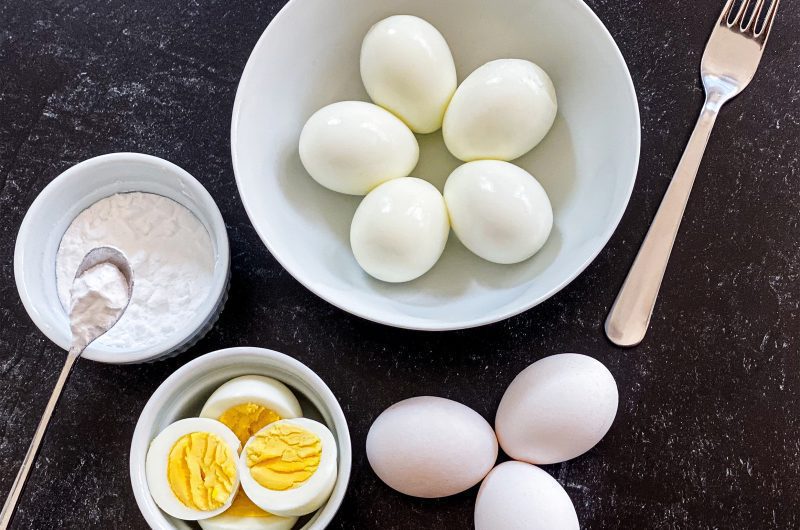Eggs are among the most convenient, affordable and versatile foods you can find. They can be fried, scrambled, poached, soft boiled or hard boiled, eaten as a stand-alone snack or added to practically any dish. Here at That Salad Lady, hard-boiled eggs are one of our salad bowl staples. It’s just something about the unique flavor, texture and nutritional boost they bring to a bowl.
You probably already know though that hard-boiled eggs are not all equal.
The runny yolks of undercooked eggs are off-putting while the greenish hue and rubbery texture that comes with overcooking isn’t at all appetizing. Whether undercooked or overcooked, bad hard-boiled eggs can ruin a whole salad. For this reason, many shoppers are turning to pre-boiled eggs for convenience, but we think you’ll find this recipe so easy, you’ll want to prep your own.

Without any guesswork or special tricks, our hard-boiled eggs recipe lays out all the steps you’ll need to take to make them as perfect as your salad bowls.
THE BALANCING ACT
You might be wondering why we use eggs so much. Due to their cholesterol-rich yolks, many have labeled eggs as dietary devils. Despite common belief, dietary cholesterol (the cholesterol found in the foods we eat) contributes very little, if any, to the development of high cholesterol and related health problems. Regularly eating eggs could even help raise HDL (“good”) cholesterol.
If you choose to include eggs in your salads and in your diet, rest assured knowing that they’re incredibly nutritious.

Besides being an excellent source of high-quality protein, egg yolks are packed with good fats and a cocktail of micronutrients and antioxidants, many of which aren’t found in other foods. Notably, they contain all four fat-soluble vitamins, which collectively support a healthy metabolism and a range of bodily functions (study up in our Nutrition Glossary to learn more).
Now, as you’ve likely noticed, there are a lot of different types of eggs on the market. We hate to “break” it to you, but an egg isn’t just an egg.
So, what are the healthiest eggs you can choose and why?
Some of the Different Types of Eggs
From cage-free and free-range to organic and pastured, it’s easy to get confused by all the different classifications of eggs. To help you choose with confidence, we’ll highlight some of the most common types below. All eggs do have something in common: they all come from hens (female chickens). The differences lie in how the hens are raised and what they are fed. Generally, grass-fed hens are considered to be a healthier option than grain-fed.
So, let’s “crack” open the different types:
Conventional Eggs
Your standard supermarket eggs, conventional eggs are those produced from caged grain-fed hens that are kept indoors. These eggs will almost always come at a relatively low price. As conventional eggs are naturally rich in protein and are usually supplemented with essential vitamins and minerals, there’s often not much of a difference in their overall micronutrient content compared to other types.
Cage-Free Eggs
Similar to conventional eggs, cage-free eggs come from hens kept indoors. Instead of being caged, these hens are housed in barns or sheds where they have more room to roam. Cage-free hens are generally grain-fed. Like conventional eggs, there’s typically supplementation, so the overall nutritional quality is pretty much the same. Uncaged versus caged is not necessarily the best justification for the higher price point.

Free-Range Eggs
As the name implies, free-range eggs come from hens allowed to roam freely outdoors. These hens may or may not be grass fed but they are thought to be healthier and thereby produce higher-quality eggs since they tend to be more active and “free.” Free-range eggs cost more than conventional and cage-free eggs. The added costs might not be justified since no real nutritional differences have been evidenced.
Pastured Eggs
Similar to free-range hens, pastured hens are generally outdoors and have plenty of space to roam. They can also leave their barns at any time to freely feed on grass and are never given antibiotics. When compared to conventional varieties, the eggs pastured hens produce tend to house more nutrients (omega-3s and fat-soluble vitamins) because of their feed.
Pastured eggs do come at a cost. In fact, these eggs can be even more expensive than organic eggs but we do consider it justifiable if it fits your budget.
Organic Eggs
To be considered “organic,” eggs must come from hens fed only organic feed. The feed, however, is not necessarily grass. The organic label essentially means the feed is free of animal by-products, synthetic fertilizers, pesticides or other chemical additives. In addition, no genetically modified foods, hormones or other drugs can be used in organic egg production.
Like pastured eggs, organic varieties are generally on the costlier side, largely due to production costs. Unlike pastured eggs, the choice between conventional and organic eggs is purely a matter of preference, not nutrition. If animal welfare and environmental impact are concerns, organic eggs may be worth the splurge, but nutritional quality alone doesn’t justify the cost.

As for white versus brown eggs, well, that’s just a difference in the breed of the hen – really!
Things to Consider When Choosing Eggs
We at That Salad Lady are all about making healthy food choices easier, more accessible and more affordable. As you consider choosing from the laundry list of different eggs, first consider your budget. Pastured and organic varieties are great choices, especially from an environmental sustainability standpoint, but the markup can be as much as 80%!
If you need to save on your ingredients, you can still get a hefty dose of high-quality protein, vitamins and other valuable nutrients by going the conventional route. There is no shame in choosing the best option for your budget – it could be conventional today and pastured tomorrow.
Once you have the eggs in your basket, it’s time to make the perfect hard-boiled egg.
GET COOKING
To start, you’ll need a small saucepan with a lid, eggs (of course), baking soda (about half a teaspoon) and cold water straight from your faucet. That’s it!
The recipe calls for a maximum of eight large eggs – a small saucepan generally holds about this much. You’ll just place the eggs in a single layer at the bottom of the saucepan. The more eggs you use, the more water you’ll need to cover them. The eggs should be covered to the point at which there’s about an inch of water above them. Once you’ve added the water, add the half a teaspoon of baking soda to the saucepan. The baking soda will make them much easier to peel.

The next step is to bring the water to a full boil. When the water starts to boil, turn off the heat, cover the eggs with your lid and let them sit for about 7-9 minutes. If you have an induction stove or a stove that doesn’t retain heat, we recommend simmering the eggs covered at a lower temperature (for an additional minute or so) before turning it off

After you’ve turned off the stove, the eggs will continue to cook in the hot water – this’ll give you a creamy, but firm textured hard-boiled egg, which is perfect for salad making. At the 7-9-minute mark, remove the lid, strain the water from the saucepan and run cold water over the eggs. This will immediately stop the eggs from cooking. You can start peeling the eggs once they are cool to the touch.

The Versatility of Hard-Boiled Eggs
At under 80 calories each, hard-boiled eggs not only make the perfect addition to a salad bowl but eating them is also a great way to curb hunger and suppress appetite. Simply chop or slice your hard-boiled eggs and use them as a salad topper or enjoy them whole as a standalone snack.

If egg yolks aren’t your thing, just enjoy the whites as they’re also a valuable source of protein. Hard-boiled eggs can be stored in a tightly covered container for up to five days.
SHOW US YOUR WORK
That Salad Lady wants to see all your great work. If you enjoy your hard-boiled eggs, which we are sure you will, drop a comment below and tag pics on Instagram with @thatsaladlady, #thatsaladlady and #buildyourbowl. If you love it, pin it on Pinterest and share it on Facebook and Twitter using #thatsaladlady.
This information is provided as a courtesy and is only an estimate. Please review our full disclaimer to get a clear understanding of the nutrition and health information and resources presented and written on our website.







Pingback: An Easy Recipe for Crafting the Perfect Mason Jar Salad - That Salad Lady